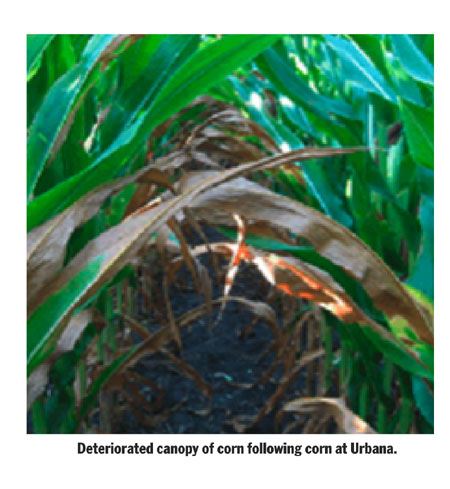Leaf Loss In Stressed Corn
URBANA, ILL.
As the dry weather continues and the Illinois
corn crop rating continues to slip, we’ve received
reports of loss of lower leaves with
what seem to be different symptoms than we
usually see under dry conditions. I’ve written before
about the effects of canopy loss, and we expect
loss of leaves like this to decrease the ability
to fill kernels.
The symptoms in some cases seem to be related
to N deficiency, with the V-shaped yellowing
starting at the tip of lower leaves, then
expanding down the leaf, eventually resulting
in death of the entire leaf. In other cases,
though, the outside edges of the leaf seem to be
affected first, which is often a symptom of K deficiency,
and affected leaf tissue often dies rapidly.
The photo of a corn crop canopy shows
leaves with both types of patterns.

The fact that the leaf area died quickly and
that symptoms do not consistently follow the
normal patterns of N loss and firing of lower
leaves under dry conditions lead some to think
that these might be symptoms of Goss’s wilt.
Goss’s wilt, which is caused by a bacterium,
has been found in central Illinois this year, and
dead patches of leaf area are a primary symptom.
But few have seen the shiny, dried bacterial
ooze that usually accompanies this disease,
and the symptoms are primarily appearing on
lower leaves first. A sample of dead leaf tissue
from a field in Piatt County this past week was
positive for presence of the Goss's wilt bacterium,
but it did not show other signs usually
apparent when that disease is the primary
cause.
So what might this problem be? In the study
from which the photo was taken, higher N rates
show nearly as much of this as lower N rates,
though the plots with higher N rates have more
intact leaf area left to help fill grain. The death of
leaf edges could be a symptom of K deficiency,
though it's somewhat late in the season to be
seeing that, and if there was the typical yellowing
it didn't last long.
Deficiency of both N and K, though, would be
brought on or made worse by lack of soil water,
and it’s likely that the basic cause of this loss of
leaf area is that inadequate soil water (along
with nutrients) finds its way to the roots for uptake.
Corn following soybeans shows much less
of this in most cases, and it also shows less leaf
curling or wilting due to inadequate water as the
hot, dry weather continues.
While we would like to establish a cause for
such leaf loss, the fact remains that some
amount of lower leaf tissue is dead in these
fields, and the canopy that is left will be less able
to intercept light and produce sugars to fill
grain. In the plot where I took the photo, kernel
numbers are modest – around 350 per ear – and
32,000 such ears would produce around 125
bushels if they fill to a low-average weight.
Most of the corn planted before May 15 is now
in the dough stage, and kernel losses to abortion
should be coming to an end. If we do get
rain in the next week, it's likely that what kernels
there are now can be filled to near-normal
size unless the canopy deteriorates further.
Based on kernel counts and canopy conditions,
however, yields of many fields in dry areas will
be less than we had hoped for. Δ
DR. EMERSON NAFZIGER: Professor Agronomy,
University of Illinois